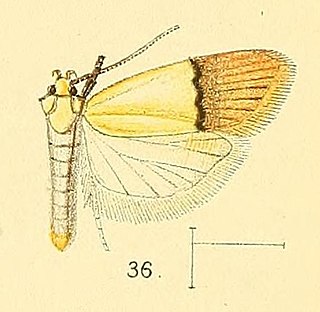
Miletus symethus, the great brownie, is a small butterfly found in India that belongs to the lycaenids or blues family. The species was first described by Pieter Cramer in 1777.

Anthene emolus, the ciliate blue, is a small butterfly found in India and southeast Asia that belongs to the lycaenids or blues family. The species was first described by Jean-Baptiste Godart in 1823.

Oreolyce vardhana, the dusky hedge blue, is a small butterfly found in Sri Lanka that belongs to the lycaenids or blues family.

The Indian fritillary is a species of butterfly of the nymphalid or brush-footed family. It is usually found from south and southeast Asia to Australia.

Eupanacra mydon, the common rippled hawkmoth, is a moth of the family Sphingidae.

Udara lanka, the Ceylon hedge blue, is a small butterfly found in Sri Lanka that belongs to the lycaenids or blues family.

The broadtail royal is a butterfly in the monotypic genus Creon, in the family Lycaenidae. It is found in South Asia.

Allophyes oxyacanthae, the green-brindled crescent, is a moth of the family Noctuidae, found in Europe. The species was described by Carl Linnaeus in his landmark 1758 10th edition of Systema Naturae.

Apamea scolopacina, the slender brindle, is a moth of the family Noctuidae. The species was first described by Eugenius Johann Christoph Esper in 1788. It is found across the Palearctic realm from central Europe to the Kuril Islands northeast of Japan.

Cerastis rubricosa, the red chestnut, is a moth of the family Noctuidae. The species was first described by Michael Denis and Ignaz Schiffermüller in 1775. It is found in most of Europe, east through the temperate regions of the Palearctic east to Japan. In the north it is found just north of the Arctic Circle. Southward it is found up to the Mediterranean Basin and Turkey.
Hellinsia venapunctus is a moth of the family Pterophoridae first described by William Barnes and Arthur Ward Lindsey in 1921. It is found primarily in the US state of Texas.

Spilosoma batesi is a moth of the family Erebidae. It was described by Walter Rothschild in 1910. It is found in Nigeria, Cameroon, Congo and Zaire.
Spinulata acutipennis is a moth in the family Cossidae. It is found in Guatemala.

Auzakia is a monotypic butterfly genus in the family Nymphalidae. It contains the single species, Auzakia danava, the commodore, which is found from Tibet to Sumatra.
Epipsestis castaneata is a moth in the family Drepanidae. It was described by Warren in 1915. It is found in Sikkim in India, Hunan in China and in Nepal and Vietnam.
Habrona concinna is a moth in the family Drepanidae. It is found in Papua and Papua New Guinea, where it has been recorded from mountainous areas.
Striginiana nobilis is a moth in the family Eupterotidae. It was described by William Jacob Holland in 1893. It is found in Gabon.
Striginiana strigina is a moth in the family Eupterotidae. It was described by Westwood in 1849. It is found in Cameroon, the Republic of Congo, Gabon, Sierra Leone, Tanzania and Uganda.

Ogdoconta margareta is a moth in the family Noctuidae. It is found in south-eastern Arizona and Sonora in Mexico.

Odites natalensis is a moth in the family Depressariidae. It was described by Lord Walsingham in 1891. It is found in the Republic of the Congo, the Democratic Republic of the Congo (Katanga), Malawi, Mozambique, South Africa (KwaZulu-Natal), Tanzania and Zimbabwe.












